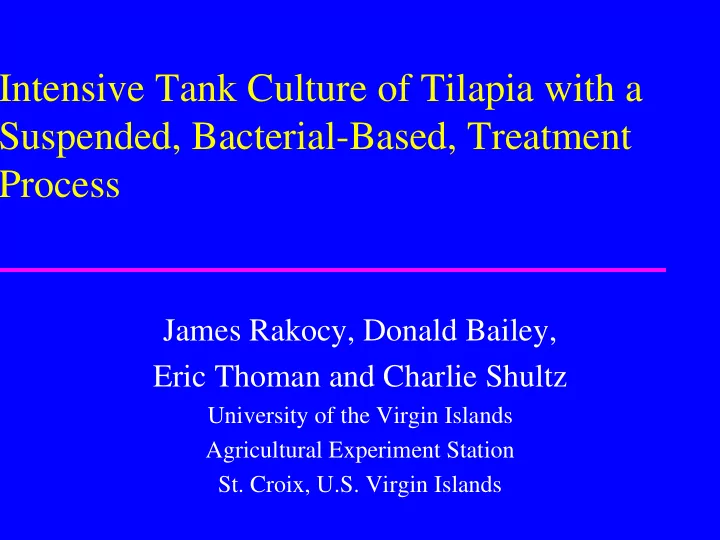

Intensive Tank Culture of Tilapia with a Suspended, Bacterial-Based, Treatment Process James Rakocy, Donald Bailey, Eric Thoman and Charlie Shultz University of the Virgin Islands Agricultural Experiment Station St. Croix, U.S. Virgin Islands
Tank Dimensions and Characteristics Size: 200 m 3 , 16 m diameter, 1 m mean water depth Block wall and 30 mil HDPE liner Surface area: 200 m 2 (0.02 ha or 1/20 acre) Bottom: 3 o slope to center Center clarifier: 1 m 3 , 45 o slope, fiberglass, 10-cm drain Outside standpipe for solids removal Aeration: three ¾-hp vertical-lift aerators Water movement: one ¾-hp vertical-lift aerator tilted horizontally
Tank Design 16 m Total Culture Volume = 200 m 3 1.09 m 0.15 m Freeboard 3º Slope Sludge Cone Volume = 1.0 m 3 Sludge Removal Line
Tank Plan View Aeration device Central cone Base addition tank Drain Flow Sludge collection and measurement To storage lagoo
Treatment Processes and Production Management Continuous aeration Mixing to maintain suspension of bacterial floc Nitrification in water column Settleable solid waste removal once daily Feed twice daily with floating feed (32% protein) Feed ad libitum for 30 – 60 minutes Monitor pH daily, maintain pH 7.5 with Ca(OH) 2 Add CaCl 2 to prevent nitrite toxicity
Production Trial Stocking Initial Final Culture Growth Final FCR Surviva Rate Size (g) Size Period Rate Biomass (%) (#/m 3 ) (kg/m 3 ) (g) (d) (g/d) 1 20 214 912 175 4.0 14.4 2.2 78.9 2 25 73.6 678 201 3.0 13.7 1.9 81.0
Major Inputs and Outputs Trial Initial Makeup Sludge Feed Base Electricity Water Water Addition (kWh/day) (L/d) (kg/day) (m 3 ) (L/day) (kg/day) 1 200 880 470 25.4 1.5 52.8 2 200 401 366 23.0 1.7 52.8
Water Quality Parameter (mg/L) Trial 1 Mean Trial 2 Mean DO 5.5 7.9 Water Temp (C) 26.8 28.5 NH 3 -N 1.2 1.8 NO 2 -N 1.5 2.7 pH 7.8 7.8 Total Alkalinity 224 204
Water Quality Parameter (mg/L) Trial 1 Mean Trial 2 Mean Chlorophyll a (ug/L) 1895 924 COD 353 363 Settleable solids (ml/L) 29 48 TSS 476 855 Ortho-Phosphate 16.9 19.2 Cl 301 317
Total Ammonia Nitrogen – Trial 1 & 2 9 8 Concentration (mg/L) Trial 1 7 Trial 2 6 5 4 3 2 1 0 1 3 5 7 9 11 13 15 17 19 21 23 25 27 29 Week
Nitrite Nitrogen – Trial 1 & 2 20 18 Concentration (mg/L) Trial 1 16 Trial 2 14 12 10 8 6 4 2 0 1 3 5 7 9 11 13 15 17 19 21 23 25 27 29 Week
Nitrate Nitrogen – Trial 1 & 2 800 700 Trial 1 Concentration (mg/L) 600 Trial 2 500 400 300 200 100 0 1 3 5 7 9 11 13 15 17 19 21 23 25 27 29 Week
Feed – Trial 1 50 kg Feed 40 Feed (kg) 30 20 10 0 0 14 28 42 56 70 84 98 112 126 140 154 168 Day
Feed – Trial 2 50 Feed (kgs) 40 30 20 10 0 1 29 57 85 113 141 169 197 Date
Sludge – Trial 1 7000 Liters 6000 5000 Liters (L) 4000 3000 2000 1000 0 0 14 28 42 56 70 84 98 112 126 140 154 168 Day
Total Suspended Solids Settling Curve 2000 Trial 1 Trial 2 1500 TSS (mg/L) 1000 500 0 0 5 10 15 20 25 30 Time (min)
Clarifier Efficiency Clarifier effluent After 10 minutes of settling Culture tank water Sludge from clarifier
External Clarifier Efficiency Influent TSS (mg/L) 1178 Effluent TSS (mg/L) 136 Sludge TSS (mg/L) 26,230 Removal (%) 88.5
Sludge – Trial 2 4500 Sludge removed 4000 Sludge removed (L) 3500 3000 2500 2000 1500 1000 500 0 1 29 57 85 113 141 169 197 Day
Sludge Removal Day 1-6 Day 7-21 Clarifier Total (kg) 175.5 184.4 Mean (kg/d) 29.2 12.3 Cone Total (kg) 5.9 4.8 Mean (kg/d) 1.0 0.3 Percentage Clarifier (%) 96.7 97.5 Cone (%) 3.3 2.5
Total Suspended Solids 2500 Concentration (mg/L) 2000 1500 Trial2 1000 500 0 0 2 4 6 8 0 2 4 6 8 0 2 4 6 8 1 1 1 1 1 2 2 2 2 2 Week
Advantages of Bacterial-Based Tank Culture Simple management Low water requirements Seepage problems avoided Not affected by algal die-offs Algae and bacteria supplement tilapia diet No off-flavor detected Production ~ 30 times higher than ponds No recruitment problem Wastewater used to irrigate and fertilize field crops
Disadvantages of Bacterial-Based Tank Culture Feeding response fluctuates Suspended solids nitrification less stable than fixed-film nitrification High energy input
Key Results Total tilapia production: 2,740 – 2,880 kg in a 0.02-ha tank Daily makeup water averaged 0.20 - 0.43% of total volume: 0.40-0.86 m 3 Recovered approximately 0.38 m 3 of water daily for irrigation and fertilization of field crops.
Future Research Scale-up (1,000 m 2 ?, 4,000 m 2 ?) Aeration requirement Size and number of clarifiers Species Economics
Conclusions A simple tank construction method was developed The tank was nearly 30 times more productive than a standard earthen pond (13.7 and 14.4 vs. 0.5 kg/m 3 ) External clarifier simplifies construction, improves solids removal and water quality and may increase production This production technology conserves water and recovers solids and nutrients
Recommend
More recommend